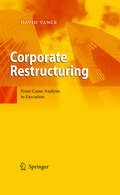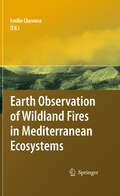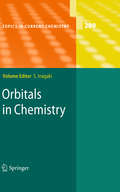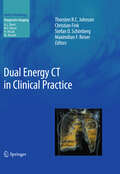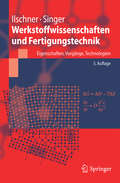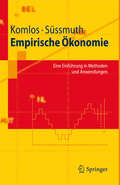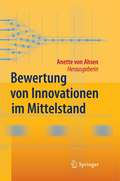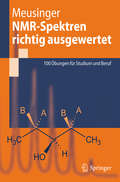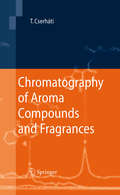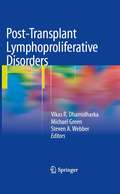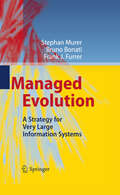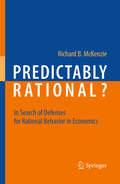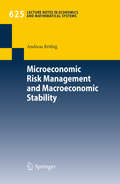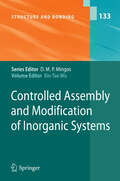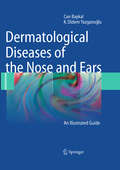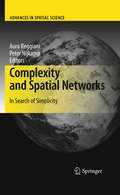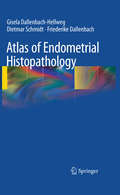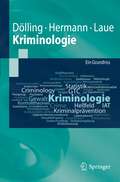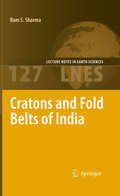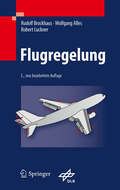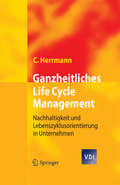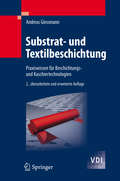- Table View
- List View
Corporate Restructuring: From Cause Analysis to Execution
by David VanceCorporate Restructuring is a practical approach to rescuing troubled companies and driving underperforming companies to top performance. It combines proven restructuring strategies with rigorous theoretical analysis. This book explains how to set and achieve asset, staffing, sales and profit goals. Topics include diagnostic tools to identify the root cause of problems, the human dynamics that cause a company to thrive or wither, customer service and relationship marketing, customer intelligence systems, new product development, process mapping, continuous process improvement and re-engineering as well as integrating IT into corporate strategy. It is also discussed how to find the resources needed to keep a company alive during restructuring and how to use bankruptcy offensively and defensively. Corporate Restructuring emphasizes execution. All the restructuring theories in the world weigh less than a simple plan, well executed.
Earth Observation of Wildland Fires in Mediterranean Ecosystems
by Emilio ChuviecoWildland fires are becoming one of the most critical environmental factors affecting a wide range of ecosystems worldwide. In Mediterranean ecosystems (including also South-Africa, California, parts of Chile and Australia), wildland fires are recurrent phenomena every summer, following the seasonal drought. As a result of changes in traditional land use practices, and the impact of recent climate warming, fires have more negative impacts in the last years, threatening lives, socio-economic and ecological values. The book describes the ecological context of fires in the Mediterranean ecosystems, and provides methods to observe fire danger conditions and fire impacts using Earth Observation and Geographic Information System technologies.
Orbitals in Chemistry
by Satoshi InagakiAimed at chemists in both academia and industry, and written by world-renowned experts in their fields, this text, made up of concise yet authoritative reports, is part of a series that presents critical reviews of current ideas and future trends in research.
Dual Energy CT in Clinical Practice
by Stefan O. Schönberg Thorsten Johnson Maximilian F Reiser Christian FinkDual-energy CT is a novel, rapidly emerging imaging technique which offers important new functional and specific information. In this book, physicists and specialists from different CT manufacturers provide an insight into the technological basis of, and the different approaches to, dual-energy CT. Renowned medical scientists in the field explain the pathophysiological and molecular background of the technique, discuss its applications, provide detailed advice on how to obtain optimal results, and offer hints regarding clinical interpretation. The main focus is on the use of dual-energy CT in daily clinical practice, and individual sections are devoted to imaging of the vascular system, the thorax, the abdomen, and the extremities. Evaluations and recommendations are based on personal experience and peer-reviewed literature. Plenty of carefully chosen high-quality images are included to illustrate the clinical benefits of the technique.
Werkstoffwissenschaften und Fertigungstechnik
by Bernhard Ilschner Robert F. SingerDie Autoren geben einen Überblick über nahezu alle Ingenieurwerkstoffe. Behandelt werden integrierende physikalische Phänomene wie z. B. atomare Bindung und Struktur, Diffusion und atomarer Platzwechsel, Vorgänge an Grenzflächen sowie die zerstörungsfreie Prüftechnik. Auch Herstellungstechnologie und Weiterverarbeitung werden dargestellt. Für die Neuauflage wurden die Kapitel zum Mikrogefüge und zur Systematik der Umwandlungen völlig neu gefasst, die einleitenden Abschnitte zu Rohstoffversorgung, Umweltbelastung und Recycling aktualisiert.
Operative und interventionelle Gefäßmedizin
by Walter Gross-Fengels Eike Sebastian DebusEin offen operatives oder interventionelles Vorgehen ist bei vielen Gefäßerkrankungen die Therapie der Wahl. Mit neu entwickelten Techniken verändern sich auch die Therapieindikationen. Aktuelles und differenziertes Praxiswissen bietet dieses Buch, zu dem zahlreiche Experten mit ihren speziellen Kenntnissen und Erfahrungen beigetragen haben. Es wendet sich ebenso an Ärzte in Weiterbildung zum Gefäßchirurgen, die ihre Facharztprüfung vorbereiten, wie als Nachschlagewerk an alle Gefäßchirurgen, interventionell tätigen Radiologen und Internisten.
Empirische Ökonomie
by Bernd Süssmuth John KomlosDas Buch führt anhand einfacher und zugleich origineller Anwendungen aus Gebieten wie Wirtschaftsgeschichte, Humankapitaltheorie oder Biologie in die Methoden der klassischen Ökonometrie ein. Da auch grundlegende Konzepte der beschreibenden und schließenden Statistik behandelt werden, sind keine Vorkenntnisse nötig. Damit stellt sich das Buch der Aufgabe, den Studierenden neben den methodischen Fertigkeiten auch Anregung und Motivation zu eigenständigem empirischen Arbeiten zu geben.
Bewertung von Innovationen im Mittelstand
by Anette Von AhsenSicherheit in der Bewertung von Innovationen ist besonders für mittelständische Unternehmen ein kritischer Erfolgsfaktor. Bei knappen Ressourcen gilt es, erfolgversprechende Projekte auszuwählen und die Wahrscheinlichkeit von Fehlschlägen zu mindern. Das Buch führt in die Grundlagen ein und stellt neue Werkzeuge und Methoden zur Bewältigung dieser Aufgabe vor. Praktiker erhalten einen Leitfaden für die Anwendung der Bewertungsinstrumente, ihre Anwendbarkeit können sie anhand von Fallstudien aus unterschiedlichen Branchen prüfen.
NMR-Spektren richtig ausgewertet
by Reinhard MeusingerDer Band enthält 100 praxisnahe und verständliche Beispiele und Übungen zur korrekten Auswertung von ein- und zweidimensionalen NMR (Nuclear Magnetic Resonance)-Spektren. Alle gängigen Problemstellungen der Spektrenauswertung werden behandelt. Außerdem enthält das Buch eine Liste der wichtigsten Spektrenparameter sowie viele praktische Hinweise. Alle Beispiele und Übungen haben sich in Kursen des Autors bewährt. Sie sind nach verschiedenen Schwierigkeitsgraden ausgewählt und insbesondere auch für das Selbststudium geeignet.
Chromatography of Aroma Compounds and Fragrances
by Tibor CserhátiThis is the only comprehensive survey of chromatographic methods for the analysis of aroma compounds and fragrances. A unique feature of the book are the extensive tables with relevant data. This will help significantly to choose an appropriate method, and to compare its characteristics with that of other methods. Coverage of applications includes food products, essential oils, as well as environmental samples. Tibor Cserháti is a recognized member of the separation science community with long-standing publishing experience. He is author or coauthor of six books and more than 490 scientific papers.
Post-Transplant Lymphoproliferative Disorders
by Michael Green Vikas R. Dharnidharka Steven A. WebberPost-transplant lymphoproliferative disorders are a group of conditions that straddle the borders between infection and malignancy. They were very rare prior to the mid-1980s but now can be expected to develop in 1-10% of transplant recipients. While some cases are reversible with reduction in immunosuppression, more severe forms are indistinguishable from frank lymphomas. This book sets out to cover in depth every aspect of these disorders, including both basic science and clinical topics. The epidemiology is reviewed, and careful attention is paid to the role of Epstein-Barr virus in their development. Clinical features are documented and clear guidance is provided on diagnosis, with thorough description of pathologic and imaging findings. Further chapters are devoted to treatment, prognosis, preventive and pre-emptive strategies, and organ-specific considerations. The state-of-the-art information contained in this book will aid researchers as well as the many different professionals involved in caring for patients with post-transplant lymphoproliferative disorders. The comprehensive and detailed coverage will appeal to those who already have some expertise in the field, yet the book will also serve as an invaluable resource for beginners in transplantation.
Very Large Information Systems: Managed Evolution as a Strategy
by Stephan Murer Bruno BonatiMany organizations critically depend on very large information systems. In the authors' experience these organizations often struggle to find the right strategy to sustainably develop their systems. Based on their own experience at a major bank, over more than a decade, the authors have developed a successful strategy to deal with these challenges, including: - A thorough analysis of the challenges associated with very large information systems - An assessment of possible strategies for the development of these systems, resulting in managed evolution as the preferred strategy - Describing key system aspects for the success of managed evolution, such as architecture management, integration architecture and infrastructure - Developing the necessary organizational, cultural, governance and controlling mechanisms for successful execution
Predictably Rational?
by Richard B. MckenzieMainstream economists everywhere exhibit an "irrational passion for dispassionate rationality." Behavioral economists, and long-time critic of mainstream economics suggests that people in mainstrean economic models "can think like Albert Einstein, store as much memory as IBM's Big Blue, and exercise the will power of Mahatma Gandhi," suggesting that such a view of real world modern homo sapiens is simply wrongheaded. Indeed, Thaler and other behavioral economists and psychology have documented a variety of ways in which real-world people fall far short of mainstream economists' idealized economic actor, perfectly rational homo economicus. Behavioral economist Daniel Ariely has concluded that real-world people not only exhibit an array of decision-making frailties and biases, they are "predictably irrational," a position now shared by so many behavioral economists, psychologists, sociologists, and evolutionary biologists that a defense of the core rationality premise of modedrn economics is demanded.
Natural Heritage from East to West
by Francesco Mauro Vahap Tecim Niki Evelpidou Tomás De Figueiredo Andreas VassilopoulosThe publication is an initiative generated within the European Project Leondardo da Vinci Pilot Project "EduNatHer", Educational Strategies for the Promotion of Natural Heritage and was co-funded by the European community. The Leonardo da Vinci Pilot Project is one of the longest-running instruments supporting cooperation among educational organizations, scientists and researchers across Europe. The book is the result of cooperative work among academic and research institutes originating from six countries; Greece, Romania, Portugal, Italy Malta and Turkey, and its focus is to present natural landmarks and monuments from those countries. The main objective of the book is to construct a meaningful link between educational organizations, research institutes, public and private sectors involved in research, preservation and management of natural sites. Each country presents up to 15 natural sites of environmental or educational interest within a geographical zone spanning Europe from east to west.
Microeconomic Risk Management and Macroeconomic Stability
by Andreas RöthigWhile the determinants of firms' optimal hedging strategies on the micro level are well understood, there is rarely any literature dealing with macroeconomic consequences of microeconomic risk management. This book is concerned with the impact of diverse hedging policies on macroeconomic stability. It addresses this issue by employing theoretical as well as empirical methods.
Dermatological Diseases of the Nose and Ears
by K. Didem Yazganoglu Can Baykal"Dermatological Diseases of the Nose and Ears" gives comprehensive information about the lesions of these regions. It contains high quality original clinical pictures, which make the diagnosis easier in this important aspect of clinical dermatological practice. All diseases involving the nose and ears are discussed separately with a clinical differential diagnostic approach. As a result approximately 600 different diseases are addressed in the book. In clinical practice, physicians may observe lesions of the nose or ear only. After identifying the elementary lesion, the clinician can more easily uncover the diagnosis of a local or disseminated or systemic disease with the help of this book. Furthermore, this color illustrated book guides the reader to the diagnosis of the prevalent skin tumors frequently involving these localizations, addressing an important health care problem.
Complexity and Spatial Networks: In Search of Simplicity (Advances in Spatial Science)
by Peter Nijkamp Aura ReggianiThis book offers a panoramic view of recent advances in spatial complexity, in order to enhance our understanding of complex spatial networks by simplicity in terms of both the basic driving forces of systemic impacts and the modelling of such systems. Simple models mapping out the evolution of complex networks are undoubtedly a key issue in spatial economic research. In exploring this untrodden ground, this volume pursues new interdisciplinary pathways for theoretical, methodological and empirical analysis in the complex interconnected space-economy. It highlights 'evolutionary' directions and 'unifying' perspectives in this fascinating research field.
Atlas of Endometrial Histopathology
by Dietmar Schmidt Gisela Dallenbach-Hellweg Friederike DallenbachThe prime purpose of this atlas is to help the pathologist find, classify and differentially diagnose the changes he is observing. Information on the daily changes during the menstrual cycle and how to date them is essential for recognizing changes caused by abnormal endogenic and iatrogenic hormonal stimuli in functional endometrial disturbances. To provide their patients with the proper hormonal therapy, gynecologists cannot rely on blood samples only because of the constantly fluctuating hormonal levels. A precise functional diagnosis of the endometrial biopsy is the most accurate and best means for assessing hormonal action. Numerous microphotographs explain in detail how to recognize the normal and pathological changes that can develop in the endometrium. The subject of endometritis and the complex endometrial neoplasms and their precursors, with their differential diagnosis as well as their clinical prognosis are covered in detail. To complete the endometrial histopathology, gestational changes are reviewed and illustrated in the last chapter.
Kriminologie: Ein Grundriss (Springer-Lehrbuch)
by Dieter Hermann Christian Laue Dieter DöllingDas Lehrbuch vermittelt die Grundlagen der Kriminologie (Begriff, Geschichte und Methoden), erläutert die Kriminalitätstheorien und arbeitet zentrale Befunde zum Verbrechen, zu Tätern und Opfern von Verbrechen sowie zur Verbrechenskontrolle (Kriminalprävention und Strafrechtspflege) heraus. Sodann werden wichtige Deliktsbereiche unter kriminologischen Gesichtspunkten dargestellt. Statistische und methodische Grundlagen empirisch-kriminologischer Untersuchungen werden jeweils berücksichtigt.
Cratons and Fold Belts of India (Lecture Notes in Earth Sciences #127)
by Ram SharmaCratons and Fold Belts of India, is a unique attempt at presenting geological characteristics and evolution of the fold belts and the cratonic areas of the Indian shield. The author has evaluated the different evolutionary models for each fold belt in light of all the currently available geological and geochronological informations that are clearly listed. Shortcomings, if any, of each model are stated and a viable geodynamic model is presented for each fold belt. The book is self-contained - it includes an introduction to the processes of mountain building, especially plate tectonics theory with its application to the evolution of the Himalaya as an illustrative example - so that the reader can better appreciate the novel approach to the evolution of Proterozoic fold belts. The author eschews a detailed account of the fold belts for a clear description of all the concepts that go into building models. It is primarily written for graduate students, teachers and for those geoscientists who aspire to know all about the Indian shield.
Flugregelung
by Wolfgang Alles Rudolf Brockhaus Robert LucknerDas Buch liefert die Grundlagen für den Vorentwurf von Flugregelungssystemen. Der systematische Aufbau führt Leser von einfachen Strukturen für Dämpfer, Autostabilisatoren und Lageregler hin zu komplexen Gesamtsystemen (Automatic Flight Control System).
Ganzheitliches Life Cycle Management
by Christoph HerrmannWenn Unternehmen die Anforderungen einer nachhaltigen Entwicklung umsetzen, stehen sie vor der zentralen Aufgabe, Produkte und Prozesse lebensphasenübergreifend zu betrachten. Der Autor stellt die Gestaltungsmöglichkeiten des Life Cycle Managements vor und unterscheidet zwischen lebensphasenbezogenen Disziplinen wie z. B. dem Produkt- und Produktions-Management sowie lebensphasenübergreifenden Disziplinen (z. B. Informations- und Wissensmanagement). Zahlreiche Anwendungsbeispiele und Abbildungen dienen der Veranschaulichung der Inhalte.
Substrat- und Textilbeschichtung
by Andreas GiessmannDas Buch liefert einen Überblick über Verfahren und Technologien der Beschichtungs- und Kaschierindustrie, die insbesondere bei der Herstellung technischer Textilien zum Einsatz kommen. Der Autor behandelt unterschiedliche Substrate und Beschichtungsmassen, die Verfahrenstechnik sowie Anlagen und Anlagenkomponenten. In der 2. Auflage werden neue, verbesserte Trocknungssysteme sowie die Beschichtung medizinischer Produkte beschrieben. Ferner wurde die aktuelle Auflage um ein Kapitel zur Anwendung von Plastisolen und Additiven ergänzt.
